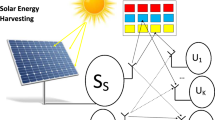Abstract
Express evolution in smart wireless communication address the issue of spectrum scarcity. Implementation of cognitive radio (CR) is one of the promising technologies for the effective utilization of spectrum. Sensing is the critical component of cognitive radio. Moreover, encouraged by the element of sensing is critical for consistently defining spectral opportunity and succeeding opportunity in spectrum access for the fifth generation (5G) wireless networks. Universal filtered multicarrier—Isotropic Orthogonal Transform Algorithm (UFMC-IOTA) is the excellent 5G waveform candidates. This article focuses on the performance of UFMC-IOTA based CR transceiver sensing challenges, downlink capacity of cognitive radio network (CRN). Simulation results also demonstrate that the proposed transceiver outperforms the capability of sensing than the conventional sensing methodologies in CRN. It also increases the detection probability of CRN at very low SNR level.












Similar content being viewed by others
References
Mitola, J., & Maguire, G. Q., Jr. (1999). Cognitive radio: Making software radios more personal. IEEE Personal Communication Magazines, 6(4), 13–18.
Ahmad, A., Ahmad, S., Rehmani, M. H., & Hassan, N. U. (2015). A survey on radio resource allocation in cognitive radio sensor networks. IEEE Communications Surveys & Tutorials, 17(2), 888–917.
Meshkova, E., et al. (2017). Designing a self-optimization system for cognitive wireless home networks. IEEE Transactions on Cognitive Communications and Networking, 3(4), 684–702.
Sutton, P. D., Nolan, K. E., & Doyle, L. E. (2008). Cyclostationary signatures in practical cognitive radio applications. IEEE Journal on Selected Areas in Communications, 26(1), 13–24.
Vitturi, S., Zunino, C., & Sauter, T. (2019). Industrial communication systems and their future challenges: Next-generation ethernet, IIoT, and 5G. Proceedings of the IEEE, 107(6), 944–961.
Guan, P., et al. (2017). 5G field trials: OFDM-based waveforms and mixed numerologies. IEEE Journal on Selected Areas in Communications, 35(6), 1234–1243.
Liu, Y., et al. (2017). Waveform design for 5G networks: Analysis and comparison. IEEE Access, 5, 19282–19292.
Chen, X., Wu, L., Zhang, Z., Dang, J., & Wang, J. (2018). Adaptive modulation and filter configuration in universal filtered multi-carrier systems. IEEE Transactions on Wireless Communications, 17(3), 1869–1881.
He, Z., Zhou, L., Yang, Y., Chen, Y., Ling, X., & Liu, C. (2019). Compressive sensing-based channel estimation for FBMC-OQAM system under doubly selective channels. IEEE Access, 7, 51150–51158.
Zhang, L., Ijaz, A., Xiao, P., Wang, K., Qiao, D., & Imran, M. A. (2019). Optimal filter length and zero padding length design for universal filtered multi-carrier (UFMC) system. IEEE Access, 7, 21687–21701.
Spooner, C. M., & Mody, A. N. (2018). Wideband cyclostationary signal processing using sparse subsets of narrowband subchannels. IEEE Transactions on Cognitive Communications and Networking, 4(2), 162–176.
Shen, J., & Alsusa, E. (2013). Joint cycle frequencies and lags utilization in cyclostationary feature spectrum sensing. IEEE Transactions on Signal Processing, 61(21), 5337–5346.
Dayana, R., & Kumar, R. (2016). Co-operative cyclo-stationary feature detection with universal filtered multi-carrier spectrum sensing for cognitive radio network. In: 2016 IEEE international conference on recent trends in electronics, information and communication technology (RTEICT), 2016.
Men, H., Zhao, N., Jin, M., & Kim, J. M. (2015). Optimal transceiver design for interference alignment based cognitive radio networks. IEEE Communications Letters, 19(8), 1442–1445.
Heydari, K., Azmi, P., Arand, B. A., & Heydari, A. (2018). Detection of the chirp signal features caused by Doppler phenomenon in the presence of destructive agents based on cyclostationary and Hough transform methods. IET Signal Processing, 12(4), 394–402.
Nourshamsi, Neda, et al. (2019). Generalized extreme value distributions of fields in nested electromagnetic cavities. IEEE Transactions on Electromagnetic Compatibility, 61(4), 1337–1344.
Author information
Authors and Affiliations
Corresponding author
Additional information
Publisher's Note
Springer Nature remains neutral with regard to jurisdictional claims in published maps and institutional affiliations.
Rights and permissions
About this article
Cite this article
Dayana, R., Malarvezhi, P., Vadivukkarasi, K. et al. UF0MC-IOTA Based Cognitive Radio Transceiver. Wireless Pers Commun 114, 2105–2119 (2020). https://doi.org/10.1007/s11277-020-07467-z
Published:
Issue Date:
DOI: https://doi.org/10.1007/s11277-020-07467-z




